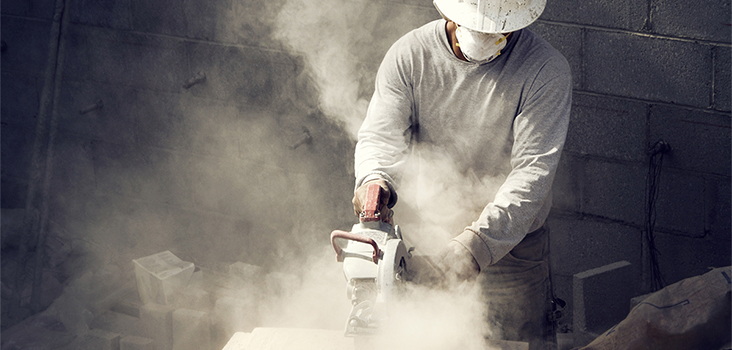
What Businesses Should Know about OSHA's Crystalline Silica Final Rule
About two million construction workers—in over 600,000 workplaces—are exposed to crystalline silica every year. Too much exposure to silica can cause serious medical conditions like silicosis, which creates scar tissue on the lungs and prevents healthy breathing. Silicosis can be fatal, and workers can get it after only a few months of high levels of silica exposure.
To help protect worker health, OSHA released a final rule in 2016 that limits the amount of crystalline silica workers can be exposed to on the job. This final rule on crystalline silica was enforced starting September 23, 2017. If you work in construction, maritime, manufacturing, or hydraulic fracturing, this rule may have a big impact on your business. Here’s what you need to know to stay compliant.
You need to do more to limit worker exposure to silica.
Limiting worker exposure to silica can take a few different forms. OSHA requires construction employers to use engineering controls like ventilation and wet saws to reduce workers’ exposure to silica dust. Depending on how much silica they’re exposed to, you may also need to provide special training and respirators or offer medical exams to highly exposed employees.
The new PEL (permissible exposure limit) is lower.
It’s now 50 micrograms of respirable silica per cubic meter, averaged over an eight-hour shift. This is half of the previous permissible exposure limit for general industry, and 20% less than the previous PEL for construction and shipyards/maritime.
The new rule impacts a lot of different industries and tasks.
Here are some examples of job tasks that are impacted:
- Abrasive blasting
- Cutting/sawing
- Drilling
- Foundries
- Grinding
- Jackhammering
- Jewelry production
- Milling
- Mixing
- Oil and gas operations
- Polishing
- Refractory product manufacturing
- Ready-mix concrete
- Refractory furnace installation and repair
- Sweeping
If your workers regularly work with concrete, glass, pottery, structural clay, paint, and cut stone, you may also be impacted by this rule. The best way to be sure is to visit OSHA’s website or talk to your local Concentra representative.
Your workers may need more silica surveillance exams and respirator fit exams.
This goes back to limiting their exposure. If your workers are exposed to a lot of respirable silica over an eight-hour period, they may need to be monitored for silica exposure, cleared to wear a respirator, and be fitted for a respirator to protect their health while they’re at work.
Silica surveillance exams require specially trained technicians.
Not every technician can perform the spirometry portion of a silica surveillance exam. The National Institute for Safety and Health (NIOSH) oversees special training for spirometry. OSHA requires the spirometry portion of a silica surveillance exam to be performed only by NIOSH certified technicians —and there aren’t a lot out there. Because of this new rule, Concentra has committed to increasing our headcount of NIOSH-certified technicians in all our markets. If you’re a current client and want to know if your market has a NIOSH-certified technician today, call your local center for more information.
A silica surveillance exam is like an asbestos exam.
The biggest differences are the spirometry must be performed by a NIOSH-certified technician and a baseline tuberculosis screening is required. Otherwise, silica exams include the basics, like a physical exam and a chest X-ray. Silica exams may be combined with respirator medical clearance and fit testing depending on exposure levels.
Not all the OSHA requirements are enforced at the same time.
OSHA is rolling out the new silica surveillance requirements on different timelines for different industries.
EDIT 4/7/2017: OSHA has changed the date of enforcement to 9/23/2017. Please see below from OSHA.
The construction standard for crystalline silica has a number of unique features warranting development of additional guidance materials. In order to provide the opportunity to conduct additional outreach to the regulated community and to provide additional time to train compliance officers, we have decided to delay enforcement of this standard until September 23, 2017. We are currently developing educational materials for employers and enforcement guidance for your staff that will be made available shortly. Please instruct your staff to provide these materials to employers that are subject to the requirements under § 1926.1153 and to provide guidance on what steps the employers can take to ensure that they are in compliance with the new provisions when enforcement begins on September 23, 2017. For the full communication, please visit OSHA's website.
Contact us if you have more questions about the crystalline silica rule, need to schedule a respirator clearance exam or fit test, or want to find out if your local Concentra has a NIOSH-certified technician.



